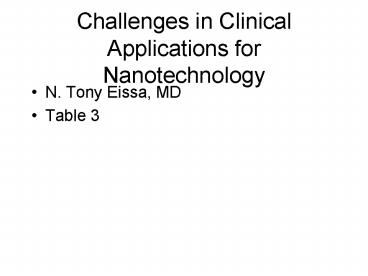Challenges in Clinical Applications for Nanotechnology - PowerPoint PPT Presentation
1 / 14
Title:
Challenges in Clinical Applications for Nanotechnology
Description:
Challenges in Clinical Applications for Nanotechnology N. Tony Eissa, MD Table 3 Identifying Clinical Targets Short-term Goal: Take existing mature conventional ... – PowerPoint PPT presentation
Number of Views:145
Avg rating:3.0/5.0
Title: Challenges in Clinical Applications for Nanotechnology
1
Challenges in Clinical Applications for
Nanotechnology
- N. Tony Eissa, MD
- Table 3
2
Identifying Clinical Targets
- Short-term Goal
- Take existing mature conventional approach
(either diagnostic or therapeutic) and enhance
their efficacy using nano technology.
3
Identifying Clinical Targets
- Diagnosis
- Early Detection of Cancer Use nanoparticles with
multiple probes to detect pre-defined changes in
specific protein levels in pre-cancerous cells. - Imaging for micrometastasis
- Staging of Cancer
4
Identifying Clinical Targets
- Therapy
- Drug Delivery Use nanoparticles targeted to
specific cancer cell surface receptors to guide
delivery - Form translational alliance between current
biotechnology and nanomedicine
5
Identifying Clinical Targets
- Some clinical areas amenable to wide use of
nanomedicine include Cancer, Diabetes,
Thrombosis, Vascular diseases, etc. - It is important to emphasize to keep open-mind
approach for potential clinical applications.
6
Key Barriers
- Toxicity
- short term - no toxicity in animals
- long term- not known
- Toxicity for both the host and the environment
should be addressed
7
Key Barriers
- Conjugation Chemistry Challenges
- Making nanoparticles that are application-specific
- Putting the drug on the particle
- Maintaining drug activity on the particle
- Making the drug come off the particle once
application is done
8
Key Barriers
- Delivery
- Ensuring Delivery to target organ/cell
- Allow systemic administration but deliver to
localized distant sites.
9
Key Barriers
- Language Barriers between various team
involved in nano medicine such as - Chemists
- Physicists
- Engineers
- Mathematicians
- Molecular cell biologists
- Clinical Physicians
10
Key Barriers
- GMP Challenges
- No standards for
- Purity and homogeneity of nanoparticles
- Manufacturing Methods
- Testing and Validation
11
Action Items
- Encourage nano applications to already mature
area of research - Use nano technology to enhance existing
diagnostic or therapeutic applications, e.g.,
imaging, drug delivery - Use established cellular recognition systems for
delivery testing
12
Action Items
- Establish NIH programs and review groups that are
nano-friendly - Fund more toxicological studies for nano
applications - Increase funding for conjugation chemistry for
nano particles
13
Action Items
- Establish training programs in nano medicine with
a focus on interdisciplinary approach - Undergraduate
- T32 graduate and post-graduate
- K12 program for nano medicine scholars
- K08, K23 physician scientist programs in nano
medicine
14
Action Items
- GMP
- NIH and FDA need to discuss with the scientific
community standards for GMP and made this
information available to investigators rather
than leaving the burden of proof to individual
investigators































